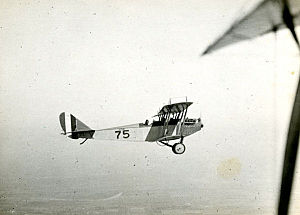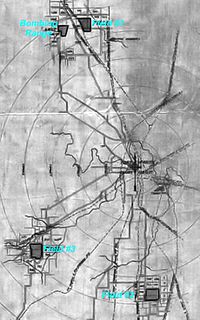
Camp Taliaferro was a World War I flight-training center run under the direction of the Air Service, United States Army in the Fort Worth, Texas, area. Camp Taliaferro had an administration center near what is now the Will Rogers Memorial Center complex in Fort Worth's cultural area near University Drive and W Lancaster Avenue.
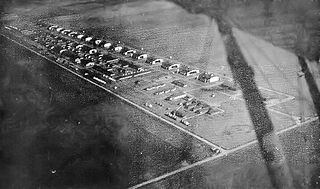
Barron Field is a former World War I military airfield, located 1.0 mile (1.6 km) West-southwest of Everman, Texas. It operated as a training field for the Air Service, United States Army between 1917 until 1921. It was one of thirty-two Air Service training camps established after the United States entry into World War I in April 1917.

Benbrook Field is a former World War I military airfield, located 0.5 miles (0.80 km) North of Benbrook, Texas. It operated as a training field for the Air Service, United States Army between 1917 until 1919. It was one of thirty-two Air Service training camps established after the United States entry into World War I in April 1917.
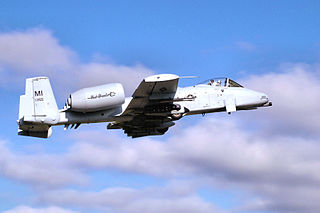
The 107th Fighter Squadron is a unit of the Michigan Air National Guard 127th Wing. It is assigned to Selfridge Air National Guard Base, Michigan and is equipped with the Fairchild Republic A-10 Thunderbolt II aircraft.

Ellington Field Joint Reserve Base is a joint installation shared by various active component and reserve component military units, as well as aircraft flight operations of the National Aeronautics and Space Administration (NASA) under the aegis of the nearby Johnson Space Center. The host wing for the installation is the Texas Air National Guard's 147th Attack Wing. Opened in 1917, Ellington Field was one of thirty-two Air Service training camps established after the United States entry into World War I. It is named for First Lieutenant Eric Ellington, a U.S. Army aviator who was killed in a plane crash in San Diego, California in 1913.

The 109th Airlift Squadron is a unit of the Minnesota Air National Guard 133d Airlift Wing located at Minneapolis–Saint Paul Joint Air Reserve Station, Minnesota. The squadron is equipped with the C-130H Hercules.

Carlstrom Field is a former military airfield, located 6.4 miles (10.3 km) southeast of Arcadia, Florida. The airfield was one of thirty-two Air Service training camps established in 1917 after the United States entry into World War I.

The 17th Weapons Squadron is a United States Air Force unit, assigned to the USAF Weapons School at Nellis Air Force Base, Nevada.

The 49th Test and Evaluation Squadron is an active United States Air Force unit. Its current assignment is with the 53d Wing, based at Barksdale Air Force Base, Louisiana.

Payne Field is a former World War I military airfield, located 4.3 miles (6.9 km) north-northeast of West Point, Mississippi. It operated as a training field for the Air Service, United States Army between 1918 until 1920.
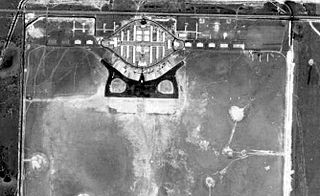
Dorr Field is a former military airfield, located 12 miles (19 km) east of Arcadia, Florida. The airfield was one of thirty-two Air Service training camps established in 1917 after the United States entry into World War I.

Hicks Field is a former World War I military airfield, located 5.6 miles (9.0 km) North-northwest of Saginaw, Texas. It operated as a training field for the Air Service, United States Army between 1917 until 1920. It was one of thirty-two Air Service training camps established after the United States entry into World War I in April 1917.
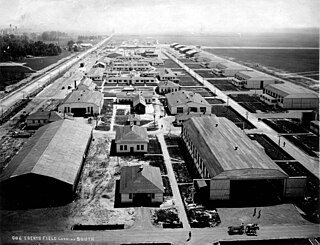
Eberts Field is a former military airfield, located 1.4 miles (2.3 km) northwest of Lonoke, Arkansas. The airfield was one of thirty-two Air Service training camps established in 1917 after the United States entry into World War I.

The 22nd Aero Squadron was a United States Army Air Service unit that fought on the Western Front during World War I.

Townsend Foster Dodd was the first commissioned US Army aviator. As a University of Illinois graduate with a Bachelor of Science in electrical engineering, he joined the Coast Artillery Corps and shortly thereafter became an aviator in the US Army Air Service. Dodd sat on many boards of review during the service's infancy and was one of the members who condemned pusher planes in favor of tractors. He served with General John Pershing on the Mexican Border where he set records for endurance flying. During World War I he was first assigned as the aviation officer of the American Expeditionary Force in 1917. He was later replaced by Colonel Billy Mitchell and was reassigned to the Bolling Mission.

With the purchase of its first airplane, built and successfully flown by Orville and Wilbur Wright, in 1909 the United States Army began the training of flight personnel. This article describes the training provided in those early years, though World War I, and the immediate years after the war until the establishment of the United States Army Air Corps Flight Training Center in San Antonio, Texas during 1926.

Call Field is a former World War I military airfield, located 4.6 miles (7.4 km) southwest of Wichita Falls, Texas. It operated as a training field for the Air Service, United States Army between 1917 until 1919. The airfield was one of thirty-two Air Service training camps established in 1918 after the United States entry into World War I.

Gerstner Field is a former World War I military airfield, located 11.1 miles (17.9 km) southeast of Lake Charles, Louisiana. It operated as a training field for the Air Service, United States Army between 1917 until 1919. The airfield was one of thirty-two Air Service training camps established in 1917 after the United States entry into World War I.

The 354th Aero Squadron was a United States Army Air Service unit that fought on the Western Front during World War I.
